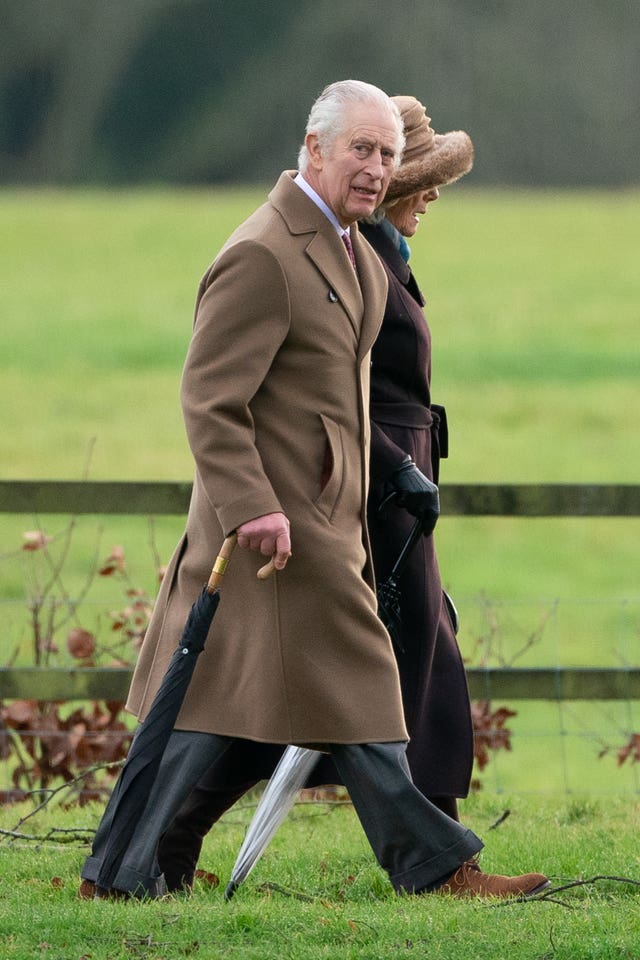
The King has become one of hundreds of thousands of Britons diagnosed with cancer every year.
Here are some questions answered about what is known so far about Charles’ condition.
– What type of cancer has he been diagnosed with?
The King, 75, has been diagnosed with an unspecified form of cancer. Buckingham Palace said that during Charles’ recent procedure for a benign prostate enlargement a “separate issue of concern” was noted.
Further diagnostic tests have identified “a form of cancer”, the Palace said.
A Palace spokesperson confirmed that it is not prostate cancer.
– What kind of diagnostic tests were performed?
Details of the type of test have not been divulged but diagnostic tests for cancer can involve blood tests, scans and biopsies.
A biopsy is a medical procedure that involves taking a small sample so it can be examined under a microscope to identify whether there are abnormal cells present.
– What is being done?
The Palace has confirmed that Charles started “a schedule of regular treatments”.
A statement from Buckingham Palace: https://t.co/zmYuaWBKw6
📷 Samir Hussein pic.twitter.com/xypBLHHQJb
— The Royal Family (@RoyalFamily) February 5, 2024
This could involve chemotherapy – a medicine is used to kill cancer cells; radiotherapy – a treatment where radiation is used to kill cancer cells; or targeted cancer drugs that find and attack cancer cells.
He will be treated as an “outpatient” which means that he will not have to stay in hospital while having treatment.
The King started his treatment on Monday and “remains at home in London this evening”, a spokesperson confirmed.
– How is the King feeling?
The Palace announced that under medical advisement, Charles will be stepping back from public-facing duties.

But he is still able to “undertake State business and official paperwork as usual”, officials said.
They added that the King “remains wholly positive about his treatment” and “looks forward to returning to full public duty as soon as possible”.
– Will his diagnosis raise awareness?
When the King shared his diagnosis of an enlarged prostate there was a significant increase in searches for the condition on the NHS website.
On the day after the announcement there were 16,410 visits to the NHS website’s prostate enlargement page compared with 1,414 visits the previous day.
Thank you to all those who have sent their good wishes during The King's hospital stay.
His Majesty is delighted that his diagnosis is having a positive impact on public health awareness. pic.twitter.com/qbaCcwQg5a
— The Royal Family (@RoyalFamily) January 29, 2024
Buckingham Palace said that the King chose to share his cancer diagnosis to “prevent speculation and in the hope it may assist public understanding for all those around the world who are affected by cancer”.
– How many people are diagnosed with cancer every year in the UK?
According to Macmillan Cancer Support around 393,000 people in the UK are diagnosed with cancer.
Figures from Cancer Research UK (CRUK) show that there are an average of 29,378 cases of cancer diagnosed among men aged 75-79 each year in the UK.
The most common cancers among men aged over 75 in the UK are prostate, lung, bowel and bladder cancer followed by melanoma skin cancer, according to the charity.
Half of people diagnosed with cancer in the UK survive for at least 10 years after their diagnosis, according to CRUK figures, but survival rates vary in each case.
Each year around 167,000 people die from cancer in the UK. In 2021 one in four deaths were caused by cancer, the charity said on its website.
When the King was Prince of Wales he was patron of a number of cancer-related charities.
He often spoke in support of cancer patients, their loved ones and health professionals.

Enjoy the convenience of having The Sunday Post delivered as a digital ePaper straight to your smartphone, tablet or computer.
Subscribe for only £5.49 a month and enjoy all the benefits of the printed paper as a digital replica.
Subscribe